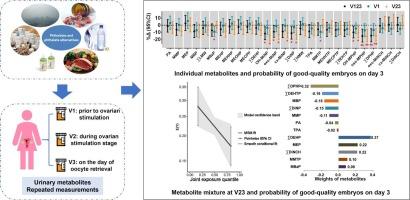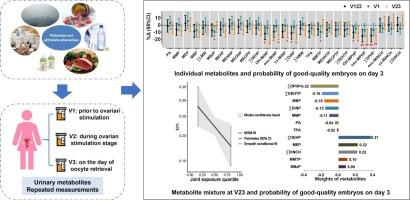在接受体外受精的妇女中,尿中邻苯二甲酸酯代谢物浓度及其替代物与生殖结果的关系:一项重复测量分析
IF 9.7
1区 环境科学与生态学
Q1 ENVIRONMENTAL SCIENCES
引用次数: 0
摘要
研究表明,邻苯二甲酸酯(PAEs)可能会破坏女性生殖健康,但很少有人探索PAEs的重复测量及其替代暴露及其对生殖结果的共同影响。目的评价接受体外受精(IVF)的女性尿液中PAE及其代谢物的反复测定与生殖结局的关系。方法本研究纳入2023年2月至10月在中国重庆接受体外受精的704名妇女。在试管婴儿治疗预约(访问1)和卵巢刺激(访问2和3)期间收集的每个参与者的三个尿液样本中,测定了23种PAE和PAE替代代谢物的浓度。试管婴儿结果从电子病历中获得。应用广义线性模型、广义估计方程和分位数g计算(QGC)来评估个体代谢物和混合物与体外受精结果的关系。结果健康风险评估显示,19.7%的参与者邻苯二甲酸二丁酯暴露水平超过安全阈值。尿中邻苯二甲酸单(2-丙基-6-氧庚基)盐[邻苯二甲酸二(2-丙基庚基)盐(DPHP)代谢物]和DPHP代谢物的总浓度(ΣDPHP)与第3天高质量胚胎的概率降低有关(分析物浓度每四分位数比值增加的百分比差异范围为- 14.0%至- 15.2%)。这些关联在卵巢刺激期间更为突出。QGC分析还显示,混合料与第3天优质胚概率呈负相关,其中∑DPHP贡献最大。结论DPHP暴露可能影响体外受精妇女胚胎质量。卵巢刺激期似乎是一个敏感期。需要进一步的研究来验证这些结果。本文章由计算机程序翻译,如有差异,请以英文原文为准。


Associations of urinary metabolite concentrations of phthalates and their alternatives with reproductive outcomes among women receiving in vitro fertilization: A repeated measurement analysis
Background
Studies suggest that phthalates (PAEs) may disrupt female reproductive health, but few have explored repeated measurements of PAE and their alternative exposure and their joint impact on reproductive outcomes.
Objectives
To evaluate the associations of repeatedly measured urinary levels of PAE and their alternative metabolites with reproductive outcomes in women receiving in vitro fertilization (IVF).
Methods
This study included 704 women undergoing IVF between February and October 2023 in Chongqing, China. Concentrations of 23 PAE and PAE alternative metabolites were determined in three urine samples of each participant collected at the IVF treatment appointment (visit 1) and during ovarian stimulation (visits 2 and 3). IVF outcomes were obtained from electronic medical records. Generalized linear models, generalized estimating equations, and quantile g computation (QGC) were applied to evaluate the relationships of individual metabolites and the mixture with the IVF outcomes.
Results
Health risk assessment indicated that 19.7 % of the participants had dibutyl phthalate exposure levels exceeding the safety threshold. Urinary concentrations of mono-(6-oxo-2-propylheptyl) phthalate [a metabolite of di-(2-propylheptyl) phthalate (DPHP)] and sum concentrations of DPHP metabolites (ΣDPHP) were related to decreased probability of good-quality embryos on day 3 (percent differences in each interquartile ratio-fold increase of the analyte concentrations ranged from −14.0 % to −15.2 %). These associations were more prominent during ovarian stimulation. QGC analyses also showed a negative association between the mixture and the probability of day 3 good-quality embryos, with ∑DPHP contributing the most.
Conclusions
Exposure to DPHP may impair embryo quality in women receiving IVF. The ovarian stimulation stage seems to be a sensitive period. Additional studies are needed to validate these results.
求助全文
通过发布文献求助,成功后即可免费获取论文全文。
去求助
来源期刊

Environment International
环境科学-环境科学
CiteScore
21.90
自引率
3.40%
发文量
734
审稿时长
2.8 months
期刊介绍:
Environmental Health publishes manuscripts focusing on critical aspects of environmental and occupational medicine, including studies in toxicology and epidemiology, to illuminate the human health implications of exposure to environmental hazards. The journal adopts an open-access model and practices open peer review.
It caters to scientists and practitioners across all environmental science domains, directly or indirectly impacting human health and well-being. With a commitment to enhancing the prevention of environmentally-related health risks, Environmental Health serves as a public health journal for the community and scientists engaged in matters of public health significance concerning the environment.
 求助内容:
求助内容: 应助结果提醒方式:
应助结果提醒方式:


